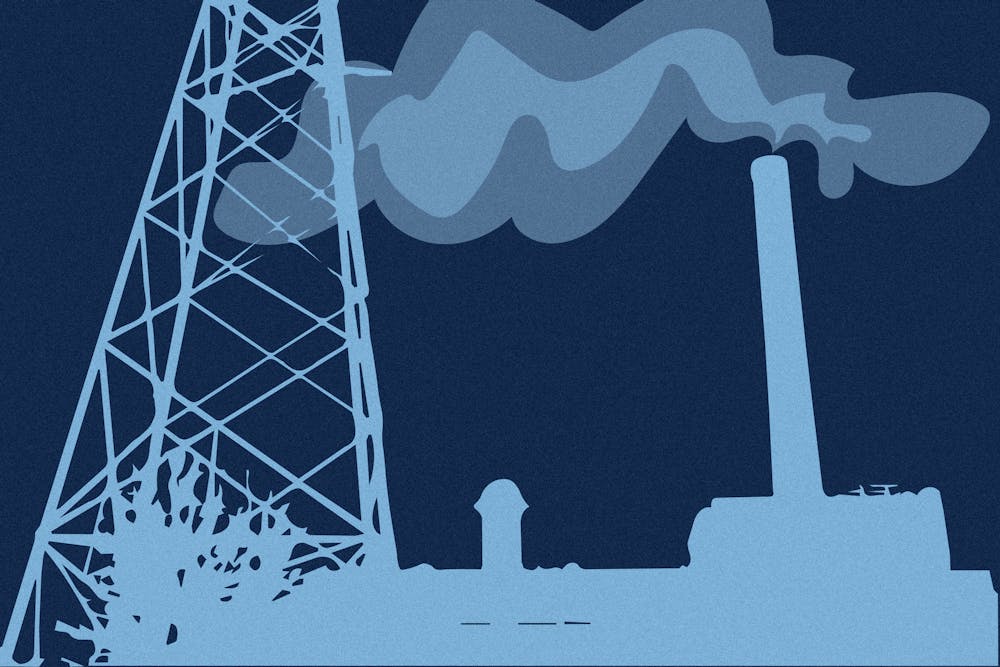A causal link has not been proven in these specific cases, but testing and research is ongoing.
Coal ash, when exposed to the open air, can be spread around during extreme weather, such as wind or flooding. A 40-foot cliff of exposed coal ash exists on the 828 site and during heavy rainfall, coal ash runoff flows into Bolin Creek, which flows into Jordan Lake — the drinking water supply for Cary, Pittsboro and other parts of the Triangle.
“What's really, really troubling is that the coal ash is sitting in the water table,” de Jong said. “When they took samples up from the groundwater, there was actual ash sitting in the groundwater samples they pulled up. So, it's thoroughly contaminated.”
Aside from the health risks, coal ash dumps are prone to structural collapse. In Mooresville, a 20-foot sinkhole opened up and released coal ash into Lake Norman. A sinkhole has already begun to form at the 828 site but has been temporarily repaired with rocks and dirt.
The coal plant also has a history of prompting conversations regarding environmental justice. In 2022, the Town proposed the development of affordable housing atop the 828 site, resulting in pushback from the community. Additionally, many historically Black neighborhoods in Chapel Hill are situated around the coal plant, de Jong said.
“Northside, Tin Top, you know, Pine Knolls — all these historically Black neighborhoods and economically poor neighborhoods that encircle the UNC coal plant are on the frontlines of receiving the brunt of that air pollution from UNC-Chapel Hill,” de Jong said.
What is the Town doing?
Under the proposed Brownfields agreement, the Town would develop a plan to cap the coal ash. Coal ash capping is typically done by draining surface water from the area and placing material atop the ash to “cap” it in place. This method does not prevent further pollution, but is less expensive than removing the ash altogether, making it an economically desirable option.
Earlier this month, the Town of Chapel Hill closed off a portion of Community Center Park — which used to be a dumping ground — on South Estes Drive due to elevated levels of lead, cadmium and petroleum in the soil, even though the waste was buried decades ago.
De Jong said that, in the past, the Town’s rationale behind capping the coal ash rather than removing it has been the risk of aerating the ash and further polluting the environment. However, the companies tasked with removing coal ash have measures to prevent this, he said.
“The problem I've seen with the town council — a lot — is that they will hire third-party investigators that somehow always give them the cheapest, [most] convenient answer that they're looking for,” Ember Penney, a member of No Coal UNC, said.
Penney said she is disappointed with the Brownfields draft agreement because the program is notorious for doing the bare minimum to keep developers from being liable for health effects to incentivize development.
To get the day's news and headlines in your inbox each morning, sign up for our email newsletters.
“No matter what we do, it’s hard," Maple Osterbrink, a volunteer for grassroots climate protection groups, said. "And if the town council just keeps pushing, and then the DEQ [says] ‘Oh, it’s legal, it’s legal,’ then there you are — somebody’s going to develop. There’s building, there’s construction, it’s disrupted, it goes in the creek and we’re back to, just, a problem."
However, Melissa McCullough, a Chapel Hill Town Council member, said that the EPA and the Brownfields program personnel will not let the Town do anything that could potentially be dangerous.
"The people at the DEQ will be working with us all the way to make sure whatever decisions that we make are safe," she said.
What can the community do?
Until July 30, community members can view and comment on the draft Brownfields agreement through the Town of Chapel Hill website. Individuals can also provide comments at an upcoming public meeting that has not yet been scheduled.
De Jong said that he believes the only responsible course of action is to remove the contaminated coal ash and dispose of it in a lined landfill where it can be isolated from the environment.
He said that the UNC coal plant is driving the environmental injustice problems present in the Chapel Hill-Carrboro area.
“It's a choice. They're making a choice to poison the community and to create environmental injustice. And it needs to stop,” he said.
@lolaoliverio
@dthcitystate | city@dailytarheel.com





